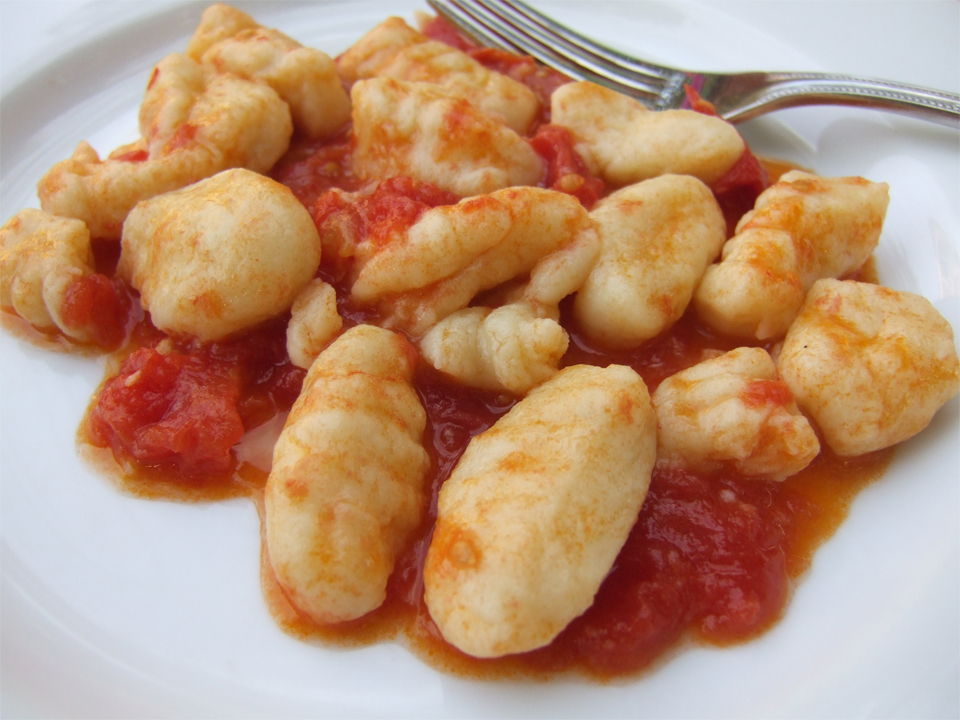
Potato Gnocchi for Renal patients

Chronic Renal Disease (CRD) is a progressive loss of kidney function, identified by higher levels of blood creatinine (>1.2mg/dL) or a falling Glomerular Filtration Rate (GFR <60mL/min/1.73m2). Patients with CRD usually exhibit high blood pressure due to fluid overload and the production of vasoactive hormones created by the kidney via the Renin-Angiotensin system. Other symptoms include azotemia and uremia, hyperkalemia, edema, hyperphospatemia and metabolic acidosis. People with CRD suffer from accelerated atherosclerosis and have an increased risk of developing cardiovascular disease (CVD). The most common causes of CRD are diabetes mellitus, hypertension and glomerulonephritis, accounting together for ¾ of all the adult cases. The most common cause of death in people with CRD is CVD rather than renal failure. Thus, the therapeutic regime is based on lowering the risk for CVD, via lowering blood pressure and via an aggressive treatment of hyperlipidemia. The dietary goals therefore are fine-tuning potassium and sodium intake as well as protein intake and improving the lipid profile. The first two help with maintaining a normotensive circulation. Products with less than 100mg sodium per serving should ideally be used and foods high in potassium such as bananas, prunes, oranges, nectarines, kiwis, raisins, potatoes, tomatoes, avocado, spinach, pumpkin, asparagus should be consumed in low amounts. Protein restriction may also aid in adjusting the osmotic pressure and thus the blood pressure, thus about 0.5 -1g of Pr / kg BW is recommended. An improvement in the lipid profile will lower the risk for CVD, and thus saturated fat should be reduced to <10% of total energy and poly- and mono-unsaturated increased to about 10-15% of total energy each. Carbohydrate intake may be limited in certain Diabetes patients; in general wholegrains and fruits are preferred (remember to check potassium content though!). The dairy intake may be reduced to avoid excess phosphorus accumulation in blood, if any, and thus low phosphorus sources such as ricotta or brie cheese may be preferred over e.g. yellow cheese and milk. Finally fluids should not be consumed in excessive amounts. The tolerated amount varies among individuals and this is empirically determined upon consultation with the physician [1].
Method
First soak potatoes for 30min at room temperature and then boil for 10min (reduces potasium by 5x) [2]. Peel and mash cooled potatoes and place in the B2B large bowl. Add flour, egg and a pinch of pepper. Combine well and turn onto a floured chopping mat. Knead lightly until dough is manageable and not too sticky, add a little more flour if the dough is too moist. Break off a portion of dough and roll to 1 cm in thickness on a floured board. Cut into 3 cm lengths and use a fork to roll a pattern into the dough. Place on a floured tray until ready to use. Continue this process until all the dough is used. Cook the gnocchi in batches in a large pot of boiling water. Remove with a slotted spoon as they rise to the top. Leach Potassium from tomatoes and pumpkin using standard leaching protocol [3] (ie peel skin off, slice in small pieces, rinse, soak for 4h in 10x water volume, rinse again). Place tomatoes and pumpkin into the base of the stack cooker with 1 teaspoon olive oil. Microwave on high for 1 minute. Add low-fat ricotta cheese. Heat on high for 4 minutes until hot. Stir through cooked gnocchi and serve.
Nutritional Analysis
This meal provides 4½ CHO exchanges. This amount would not be recommended for a Diabetic person, thus the portion size would be lower but for a normoglycemic renal patient it is fine. The fat content has been reduced by substituting cream for low fat ricotta cheese and by excluding the salami and cream pumpkin soup found in traditional Gnocchi recipes. This meal provides less than 16g of total fat and less than 6g of saturated fat, in a ratio of unsaturated:saturated of 2:1 which is optimal for lowering the risk of CVD associated with CRD. The protein content is fairly low for a main meal, only 17g, and this is mixed protein of both high and low biological availability, thus even less than what is present should be absorbed. Sodium was reduced by not adding salt (as the original recipe suggested), the value of 512mg may still be high for one serve but can be acceptable for the main meal of a CRD patient, in accordance with the recommendations of the US National Institute of Health which suggests a daily intake of no more than 2400mg sodium. The potassium content has also been reduced by pealing off the skin of potatoes (most of potassium is concentrated in the skin) as well as the leaching process, which has previously been established to reduce the potassium content by 5 times in potatoes [2]. For the same reason it is preferably to use fresh tomatoes instead of e.g. sundried ones or paste and tomato sauce, since fresh tomatoes contain less potassium. An established leaching protocol was also used for tomatoes as well as for the pumpkin [3]. The use of ricotta cheese instead of cream, also results in less phosphate content, another benefit of using this product, in addition to lowering total and saturated fat content of the meal.
References:
1. US National Library of Medicine, National Institutes of Health website: Chronic Kidney Disease
2. Louis CJ, Dolan EM. Removal of potassium in potatoes by leaching. J Am Diet Assoc 1979; 57(1):42-43
3. Renal Center Website: http://www.rd411.com/renalcenter/article1.php?ID=8pro